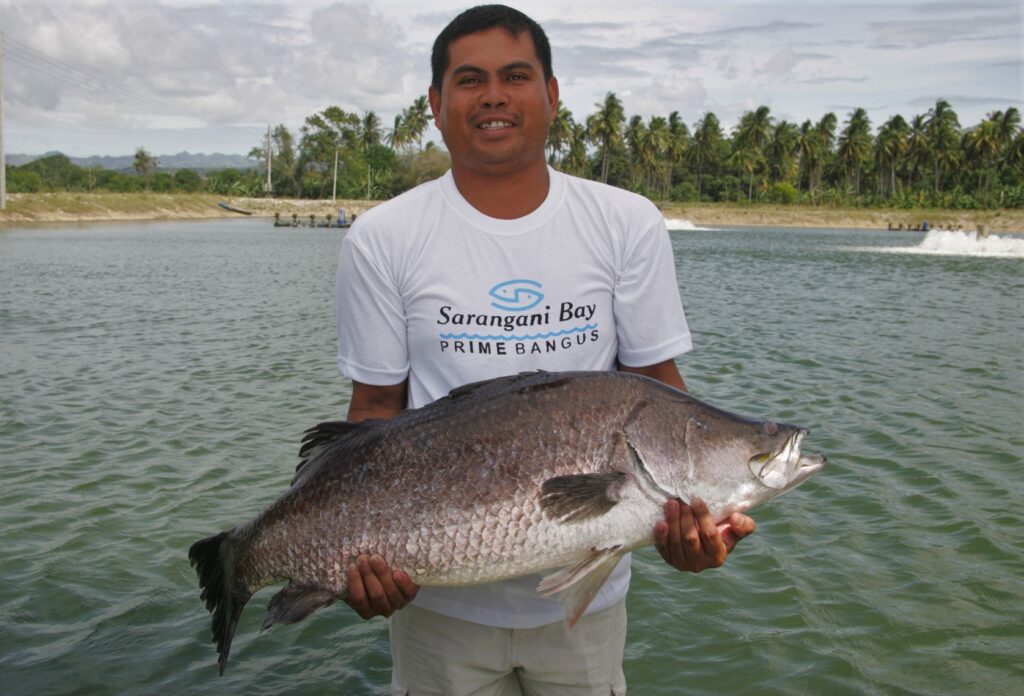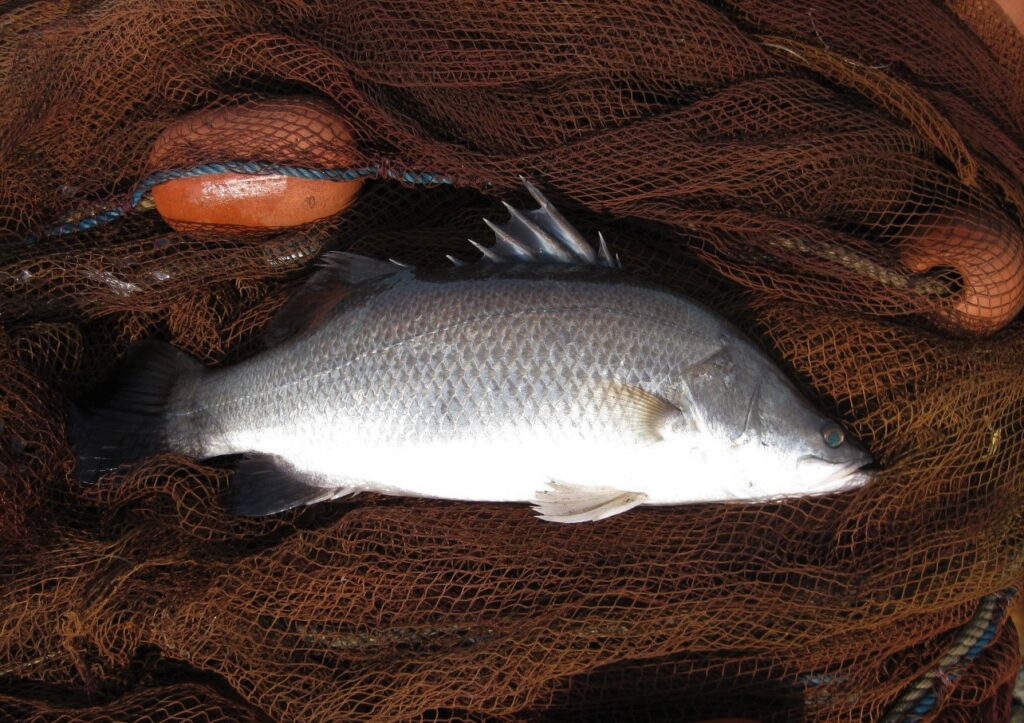Text by Henrylito D. Tacio
Photos courtesy of Rene Bocaya
If you happen to visit Queensland, Australia, you may encounter some people talking about barramundi. This “large-scaled river fish,” as what the name literally means, was originally referred to as saratoga. But the new name stuck for marketing reasons during the 1980s, a decision which has aided in raising the profile of the fish significantly.
Scientifically, the fish is called Lates calcarifer. Although it is also called Asian seabass, Australian seabass, and white seabass, it is actually a type of fish called a drum and not really a bass. Black seabass and striped bass are the real basses.
“Seabasses vary widely in size, from a few centimeters to a maximum of 2 meters and 225 kilograms in such species as the goliath grouper and 2.7 meters and 400 kilograms in the giant grouper,” says the Britannica Encyclopedia. The popular lapu-lapu is a member of the groupers.
Color also varies, both among and within species. “Some seabasses, for example, are able to change to any of several color patterns,” Britannica states. “In other species, the young may be patterned differently from the adults, and in still others individuals inhabiting deeper waters may be considerably redder than those of the same species living near shore.”
But people who eat this kind of fish generally don’t care too much about sizes, colors, or classifications. If it tastes similar, cooks similarly, then it is similar, and hence these are seabasses.
In Australia, the seabass is used to stock freshwater reservoirs as it is very popular for recreational fishing. Here in the Philippines, where the fish is locally known as apahap (other local names include kakap, bulgan, salongsong, katuyot, and matang pusa), it is highly prized in seafood restaurants because of its delectable taste.

“Seabass is a highly sought-after fish because of its white meat,” says Rene B. Bocaya, the assistant vice-president for sales of Finfish Hatcheries, Inc. “It used to be a very popular game fish when its supply was still abundant from the wild. Now, it is mostly cultured.”
The Food and Agriculture Organization (FAO) of the United Nations says seabass were historically cultured in coastal lagoons and tidal reservoirs before the race to develop the mass-production of juveniles started in the late 1960s.
“Fish culture was initially associated with salt production in coastal evaporation pans and marshes,” FAO says. “The salt was harvested during the high evaporation season of summer and autumn, and fish were cultured during winter and spring. The supply for this culture came from trapping schools of fish that lived in these estuarine areas.”
In the Philippines, the Iloilo-based Southeast Asian Fisheries Development Center (SEAFDEC) leads in seabass grow-out culture.
“Seabass is a species that is easy to culture in cages or in brackishwater ponds,” SEAFDEC says. “It is hardy, and the seedstock can be easily sourced from hatchery. There is a need, however, to include a nursery before the grow-out phase so that seabass can be easily sorted and size-graded to reduce competition for space and food, thus controlling cannibalism.”
The biggest expense for seabass culture is feed. This kind of fish is “carnivorous and must be fed with trash fish,” SEAFDEC says. “But there is already available high-protein formulated feeds that can be used for carnivorous species.”

The SEAFDEC technology of raising seabass follows:
· Stock seabass fry obtained from the hatchery in nursery cages set inside brackishwater ponds or in an estuary (mouth of the river). The net cage size may be 3 x 2 x 1.3 meters, and 600-900 pieces may be stocked. Take care to stock similar-sized fish already sorted and size-graded from the hatchery. Initial fry size is usually 1.0 to 2.5 centimeters, and the fry stays in the nursery for 30 to 45 days. Fed trash fish at 6-8% of biomass or use formulated feeds as recommended by the manufacturer. Sort and size-grade weekly.
· Transfer graded seabass to grow-out ponds or to grow-out cages. Stocking density is usually 40-50 fish per square meter which is reduced to 10-20 fish per square meter when seabasses are bigger. A one-hectare may be subdivided further into six compartments so that there is space to raise different batches of sorted and size-graded fish. A grow-out cage is bigger than nursery cages, about 4 x 4 x 3 meters. Be sure to have spare cages.
· Feed trash fish at 10% of total body weight.
· Sort and size-grade regularly. In the pond, collect fish using a net seine; in cages, simply lift the nets. Take care not to stress the fish.
· Culture period varies but is usually 3-4 months. The market size of seabass is 300-400 grams.
Like most ventures, raisers also have to deal with diseases and parasites. “These can be prevented with proper evaluation of pond sites before the culture stage,” Bocaya says. “Good culture practices such as low stocking densities and regular monitoring of cultured stocks will further prevent future problems.”
Another concern: “Since seabass is a predator fish, sustainability is a concern if it is not managed properly,” Bocaya says. “It can be cultured with other fishes, like the prolific tilapia, it is used as a biological control.”
Seabass has the potential to contribute to fisheries production in the country as it can be raised in captivity. In the past, one drawback was its scarcity of fry/fingerlings, which are available mostly in the wild.
But such is not the case anymore. There are several hatcheries where raisers could buy their fry/fingerlings. One good source is the Finfish Hatcheries, Inc., whose hatchery is located in Lun Masla, Malapatan, in Sarangani Province. “We sell only the fingerling size,” says Bocaya, a fishery expert who graduated from Bicol University.
“With good market, seabasses can be profitable,” says Dr. Rafael D. Guerrero III, the former executive director of the Laguna-based Philippine Council for Aquatic and Marine Research and Development (PCAMRD).
It was only in the 1990s when seabass had a breakthrough in the market. Later on, seabass’s juicy textured flesh and attractive silver skin have appealed to the international and local fine dining plate.
“Restaurants are the primary buyers of seabass,” says Bocaya, who describes seabass as “highly priced fish.”
Unknowingly, seabass can also be cultured in the aquarium. “It can be entertaining, especially at feeding time since it is a voracious feeder,” Bocaya says. If you like watching fish-eating fish, seabass should be the kind of fish you should raise in your aquarium.
Unfortunately, “it is not a popular fish for aquarium enthusiasts so there is little money there,” he adds.
But raisers can think of the international market for seabasses. “United States is one of the biggest export markets of seabass,” Bocaya points out.
With mariculture parks set up by the Bureau of Fisheries and Aquatic Resources around the country, “seabass will be the next big thing in the aquaculture industry,” foresees Bocaya. “It is just a matter of showing to the investors the profitability of culturing it. And our company will always be there to serve the fingerling needs of the growers.”

